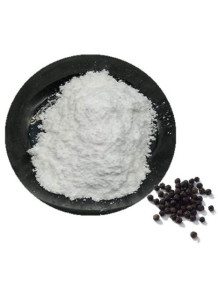Piperine (98% Purity, e.q. Bioperine)
- Product Code: 127579
เป็นสารออกฤทธิ์หลักที่พบในพริกไทยดำ (Piper nigrum) มีประโยชน์ต่อสุขภาพหลากหลายด้าน โดยได้รับการสนับสนุนจากงานวิจัยทางวิทยาศาสตร์ หนึ่งในคุณสมบัติเด่นของไพเพอรีนคือช่วยเพิ่มการดูดซึมของสารอาหารและสารออกฤทธิ์อื่นๆ
- -
- -
- -
- -
- -
- -
- -
- -
- -
- -
- -
- -
- -
- -
- -
- -
- -
- -
| Test Name | Specification |
|---|---|
| Assay (HPLC, Piperine) | 98% Min |
| Appearance | White powder |
| Odor | Characteristics |
| Sulphated Ash | 1% Max |
| Moisture | 5% Max |
| Loss on drying | 5% Max |
| Identification | Positive |
| Particle Size | 95% Pass 80 Mesh |
| pH | 9.5-10.5 |
| Heavy Metal | 10ppm Max |
| Residue on ignition | 3% Max |
| Total bacteria count | 1000CFU/g Max |
| Fungi | 100CFU/g Max |
| Pesticides | Absence |
| Salmonella | Absence |
| E.Coli | Absence |
ไพเพอรีน (Piperine) ซึ่งเป็นสารออกฤทธิ์หลักที่พบในพริกไทยดำ (Piper nigrum) มีประโยชน์ต่อสุขภาพหลากหลายด้าน โดยได้รับการสนับสนุนจากงานวิจัยทางวิทยาศาสตร์ หนึ่งในคุณสมบัติเด่นของไพเพอรีนคือช่วยเพิ่มการดูดซึมของสารอาหารและสารออกฤทธิ์อื่นๆ โดยยับยั้งเอนไซม์ที่เกี่ยวข้องกับการเผาผลาญ เช่น CYP3A4 และ P-glycoprotein ทำให้สารต่างๆ เช่น เคอร์คูมิน (curcumin) และเรสเวอราทรอล (resveratrol) ถูกดูดซึมได้ดีขึ้น นอกจากนี้ ไพเพอรีนยังมีฤทธิ์ต้านอนุมูลอิสระที่ช่วยลดความเครียดออกซิเดชันซึ่งเกี่ยวข้องกับโรคเรื้อรังหลายชนิด เช่น โรคหลอดเลือดหัวใจและมะเร็ง
ในด้านการลดการอักเสบ ไพเพอรีนสามารถลดระดับไซโตไคน์ที่ก่อให้เกิดการอักเสบในแบบจำลองสัตว์ที่มีภาวะอักเสบ อีกทั้งยังส่งผลดีต่อการเผาผลาญ เช่น ช่วยเพิ่มความไวของอินซูลิน ลดระดับน้ำตาลในเลือด และลดไขมันสะสมในตับ นอกจากนี้ยังมีศักยภาพในการปกป้องระบบประสาท โดยการปรับสมดุลของสารสื่อประสาท GABA ลดความเสียหายจากอนุมูลอิสระในเซลล์สมอง และยับยั้งเอนไซม์ acetylcholinesterase ซึ่งเกี่ยวข้องกับภาวะสมองเสื่อม ไพเพอรีนยังมีฤทธิ์ในการปกป้องตับจากพิษเคมีโดยลดระดับเอนไซม์ AST และ ALT
ในแง่ของการต้านมะเร็ง งานวิจัยบางชิ้นพบว่าไพเพอรีนสามารถยับยั้งการเจริญเติบโตของเซลล์มะเร็ง และลดการเกิดสารก่อมะเร็งที่เกิดจากการปรุงอาหารด้วยความร้อน นอกจากนี้ยังมีฤทธิ์ต้านเชื้อจุลชีพในวงกว้าง รวมถึงช่วยกระตุ้นการหลั่งน้ำย่อยในระบบทางเดินอาหาร ส่งผลให้ย่อยอาหารได้ดีขึ้น สำหรับการควบคุมน้ำหนัก ไพเพอรีนสามารถยับยั้งการสร้างเซลล์ไขมัน และยังมีฤทธิ์คล้ายสารต้านซึมเศร้า โดยเพิ่มระดับเซโรโทนินและโดปามีนในสมอง
แหล่งอ้างอิงงานวิจัย:
-
Shoba G, et al. (1998). “Influence of piperine on the pharmacokinetics of curcumin in animals and human volunteers.” Planta Medica, 64(4): 353–356.
-
Srinivasan K. (2007). “Black pepper and its pungent principle-piperine: a review of diverse physiological effects.” Critical Reviews in Food Science and Nutrition, 47(8): 735–748.
-
Mujumdar AM, et al. (1990). “Antiinflammatory activity of piperine.” Indian Journal of Pharmacology, 22(2): 69–71.
-
Chonpathompikunlert P, et al. (2010). “Neuroprotective effect of piperine on oxidative stress and cognitive impairment in mice.” Pharmacology Biochemistry and Behavior, 96(2): 234–242.
-
Lee SA, et al. (2012). “Anti-obesity effect of black pepper (Piper nigrum L.) essential oil and piperine in 3T3-L1 adipocytes and C57BL/6J mice.” Nutrition Research and Practice, 6(6): 554–561.
-
Bano G, et al. (1991). “Effect of piperine on bioavailability and pharmacokinetics of propranolol and theophylline in healthy volunteers.” European Journal of Clinical Pharmacology, 41(6): 615–617.
-
Atal CK, et al. (1985). “Bioenhancers: revolutionary concept to market.” Journal of Ayurveda and Integrative Medicine, 1(2): 96–104.
-
D’Cruz SC, et al. (2005). “Modulation of genotoxicity by piperine in mouse bone marrow cells.” Food and Chemical Toxicology, 43(7): 1117–1123.
-
Yin J, et al. (2019). “Piperine ameliorates high-fat diet-induced metabolic dysfunctions in mice through antioxidant and anti-inflammatory mechanisms.” Journal of Functional Foods, 55: 58–67.
-
Meena AK, et al. (2010). “Piperine: A review of its biological effects.” International Journal of Pharmaceutical Sciences and Research, 1(3): 1–10.
Be the first to review this product :-)
บริการวิเคราะห์
| บริการแลป | ราคา |
|---|
เป็นสารออกฤทธิ์หลักที่พบในพริกไทยดำ (Piper nigrum) มีประโยชน์ต่อสุขภาพหลากหลายด้าน โดยได้รับการสนับสนุนจากงานวิจัยทางวิทยาศาสตร์ หนึ่งในคุณสมบัติเด่นของไพเพอรีนคือช่วยเพิ่มการดูดซึมของสารอาหารและสารออกฤทธิ์อื่นๆ
ไพเพอรีน (Piperine) ซึ่งเป็นสารออกฤทธิ์หลักที่พบในพริกไทยดำ (Piper nigrum) มีประโยชน์ต่อสุขภาพหลากหลายด้าน โดยได้รับการสนับสนุนจากงานวิจัยทางวิทยาศาสตร์ หนึ่งในคุณสมบัติเด่นของไพเพอรีนคือช่วยเพิ่มการดูดซึมของสารอาหารและสารออกฤทธิ์อื่นๆ โดยยับยั้งเอนไซม์ที่เกี่ยวข้องกับการเผาผลาญ เช่น CYP3A4 และ P-glycoprotein ทำให้สารต่างๆ เช่น เคอร์คูมิน (curcumin) และเรสเวอราทรอล (resveratrol) ถูกดูดซึมได้ดีขึ้น นอกจากนี้ ไพเพอรีนยังมีฤทธิ์ต้านอนุมูลอิสระที่ช่วยลดความเครียดออกซิเดชันซึ่งเกี่ยวข้องกับโรคเรื้อรังหลายชนิด เช่น โรคหลอดเลือดหัวใจและมะเร็ง
ในด้านการลดการอักเสบ ไพเพอรีนสามารถลดระดับไซโตไคน์ที่ก่อให้เกิดการอักเสบในแบบจำลองสัตว์ที่มีภาวะอักเสบ อีกทั้งยังส่งผลดีต่อการเผาผลาญ เช่น ช่วยเพิ่มความไวของอินซูลิน ลดระดับน้ำตาลในเลือด และลดไขมันสะสมในตับ นอกจากนี้ยังมีศักยภาพในการปกป้องระบบประสาท โดยการปรับสมดุลของสารสื่อประสาท GABA ลดความเสียหายจากอนุมูลอิสระในเซลล์สมอง และยับยั้งเอนไซม์ acetylcholinesterase ซึ่งเกี่ยวข้องกับภาวะสมองเสื่อม ไพเพอรีนยังมีฤทธิ์ในการปกป้องตับจากพิษเคมีโดยลดระดับเอนไซม์ AST และ ALT
ในแง่ของการต้านมะเร็ง งานวิจัยบางชิ้นพบว่าไพเพอรีนสามารถยับยั้งการเจริญเติบโตของเซลล์มะเร็ง และลดการเกิดสารก่อมะเร็งที่เกิดจากการปรุงอาหารด้วยความร้อน นอกจากนี้ยังมีฤทธิ์ต้านเชื้อจุลชีพในวงกว้าง รวมถึงช่วยกระตุ้นการหลั่งน้ำย่อยในระบบทางเดินอาหาร ส่งผลให้ย่อยอาหารได้ดีขึ้น สำหรับการควบคุมน้ำหนัก ไพเพอรีนสามารถยับยั้งการสร้างเซลล์ไขมัน และยังมีฤทธิ์คล้ายสารต้านซึมเศร้า โดยเพิ่มระดับเซโรโทนินและโดปามีนในสมอง
แหล่งอ้างอิงงานวิจัย:
-
Shoba G, et al. (1998). “Influence of piperine on the pharmacokinetics of curcumin in animals and human volunteers.” Planta Medica, 64(4): 353–356.
-
Srinivasan K. (2007). “Black pepper and its pungent principle-piperine: a review of diverse physiological effects.” Critical Reviews in Food Science and Nutrition, 47(8): 735–748.
-
Mujumdar AM, et al. (1990). “Antiinflammatory activity of piperine.” Indian Journal of Pharmacology, 22(2): 69–71.
-
Chonpathompikunlert P, et al. (2010). “Neuroprotective effect of piperine on oxidative stress and cognitive impairment in mice.” Pharmacology Biochemistry and Behavior, 96(2): 234–242.
-
Lee SA, et al. (2012). “Anti-obesity effect of black pepper (Piper nigrum L.) essential oil and piperine in 3T3-L1 adipocytes and C57BL/6J mice.” Nutrition Research and Practice, 6(6): 554–561.
-
Bano G, et al. (1991). “Effect of piperine on bioavailability and pharmacokinetics of propranolol and theophylline in healthy volunteers.” European Journal of Clinical Pharmacology, 41(6): 615–617.
-
Atal CK, et al. (1985). “Bioenhancers: revolutionary concept to market.” Journal of Ayurveda and Integrative Medicine, 1(2): 96–104.
-
D’Cruz SC, et al. (2005). “Modulation of genotoxicity by piperine in mouse bone marrow cells.” Food and Chemical Toxicology, 43(7): 1117–1123.
-
Yin J, et al. (2019). “Piperine ameliorates high-fat diet-induced metabolic dysfunctions in mice through antioxidant and anti-inflammatory mechanisms.” Journal of Functional Foods, 55: 58–67.
-
Meena AK, et al. (2010). “Piperine: A review of its biological effects.” International Journal of Pharmaceutical Sciences and Research, 1(3): 1–10.
| Mechanism | - |
| Appearance | - |
| Longevity | - |
| Strength | - |
| Storage | - |
| Shelf Life | - |
| Allergen(s) | - |
| Dosage (Range) | - |
| Recommended Dosage | - |
| Dosage (Per Day) | - |
| Recommended Dosage (Per Day) | - |
| Mix Method | - |
| Heat Resistance | - |
| Stable in pH range | - |
| Solubility | - |
| Product Types | - |
| INCI | - |
ตะกร้า
ไม่มีสินค้า



